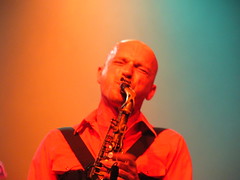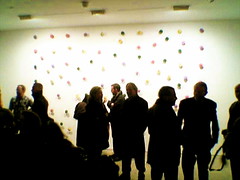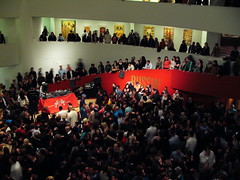 As usual, blogging slows down as life speeds up. And things have been quite intense recently, as attention shifts almost completely to my new projects. I'm finally making headway with my longer-term project for the PHENIX experiment (a little database, that should grow pretty big over time...) and we just finished an extensive week-long software workshop for ATLAS. This was really the big one for me, when I finally felt "over the hump" in terms of being able to actually use the ATLAS software, which is apparently quite powerful: but with great power comes great...complexity? Anyway, more later as I get my thoughts together (and finish a 15 page writeup of my lectures from Erice last summer, by Wednesday [gulp]).
As usual, blogging slows down as life speeds up. And things have been quite intense recently, as attention shifts almost completely to my new projects. I'm finally making headway with my longer-term project for the PHENIX experiment (a little database, that should grow pretty big over time...) and we just finished an extensive week-long software workshop for ATLAS. This was really the big one for me, when I finally felt "over the hump" in terms of being able to actually use the ATLAS software, which is apparently quite powerful: but with great power comes great...complexity? Anyway, more later as I get my thoughts together (and finish a 15 page writeup of my lectures from Erice last summer, by Wednesday [gulp]).
Monday, January 30, 2006
Time of Transition
 As usual, blogging slows down as life speeds up. And things have been quite intense recently, as attention shifts almost completely to my new projects. I'm finally making headway with my longer-term project for the PHENIX experiment (a little database, that should grow pretty big over time...) and we just finished an extensive week-long software workshop for ATLAS. This was really the big one for me, when I finally felt "over the hump" in terms of being able to actually use the ATLAS software, which is apparently quite powerful: but with great power comes great...complexity? Anyway, more later as I get my thoughts together (and finish a 15 page writeup of my lectures from Erice last summer, by Wednesday [gulp]).
As usual, blogging slows down as life speeds up. And things have been quite intense recently, as attention shifts almost completely to my new projects. I'm finally making headway with my longer-term project for the PHENIX experiment (a little database, that should grow pretty big over time...) and we just finished an extensive week-long software workshop for ATLAS. This was really the big one for me, when I finally felt "over the hump" in terms of being able to actually use the ATLAS software, which is apparently quite powerful: but with great power comes great...complexity? Anyway, more later as I get my thoughts together (and finish a 15 page writeup of my lectures from Erice last summer, by Wednesday [gulp]).
Sunday, January 22, 2006
Global Fest
No physics connection here (but I've surprised myself before) but this was a pretty neat experience. A friend and I went down to GlobalFest, a smorgasbord of world music at the Public Theater last night. While there were more than a few things to complain about (too many tickets sold, forcing many of us to wait in various lines *after* buying our not-cheap tickets!), it was a good reminder of the worlds beyond our borders, both political and mental. Naturally, there's a flickr set of a few choice photos.
Friday, January 20, 2006
Return of RHIC Round-up
While this story hasn't seemed to reach the national news, via the New York Times (why not, folks?), Newsday has been all over our story recently:
- "Bucks Mean More Bangs", Emi Endo, Newsday, January 14, 2006.
- "Short Takes", Newsday, January 17, 2006.
- "A Scholar with Vision Keeps the Collider Running", James Klurfeld, Newsday, January 20, 2006.
When Brookhaven National Laboratory managed to save one of its key nuclear physics experiments last week by using private financing to fill in federal budget gaps, the effect wasn't limited to the lab itself.
In broader terms, the lab's economic impact statewide is far more significant. Between 1993 and 2003, it added up to 79,000 jobs, $9.2 billion and a host of new technologies that cannot be entirely quantified, according to a report released Thursday by Long Island Association chief economist Pearl Kamer.
The report, which has been two years in the making, shows that the lab is one of the top five high-technology employers on the Island, with 2,750 employees. But what with visiting scientists, the development and marketing of new inventions, and the ripple effect of new technology created in the lab, it's really responsible for tens of thousands of additional, secondary jobs for the state, in industries such as construction, retail and business services, the report said.
And in the future the lab's economic effects could be even greater, with another $5.6 billion and 91,000 jobs statewide by 2014, Kamer's report predicts. Much of the trickle-down effect occurs on the Island, she said, as workers spend money and the economy grows.
Thursday, January 19, 2006
The New World
 Sorry to have been silent these last 6 days. A bunch of us went skiing in Vermont for the long weekend (and most of us returned OK...) and since then it's been chaos for me getting retooled for my post-PHOBOS life. We had an internal review of the heavy ion efforts for ATLAS, and since then I've been down with a minor cold, which gave me my only chance to work on my long-overdue PHENIX tasks. That's three acronyms in two sentences, folks. No wonder I'm having trouble keeping up.
Sorry to have been silent these last 6 days. A bunch of us went skiing in Vermont for the long weekend (and most of us returned OK...) and since then it's been chaos for me getting retooled for my post-PHOBOS life. We had an internal review of the heavy ion efforts for ATLAS, and since then I've been down with a minor cold, which gave me my only chance to work on my long-overdue PHENIX tasks. That's three acronyms in two sentences, folks. No wonder I'm having trouble keeping up.And there's a lot to keep up with, especially after last week's blockbuster news of private funding for RHIC. Just as I was returning from lunch today, I overheard a snippet of conversation: "So...we're going back to how science funding used to be...before World War II". It's really true that one just doesn't think about private citizens, or even large foundations, funding science that doesn't offer clear returns on the investment. One is used to thinking of private funding for AIDS, or even for telescopes, but rarely for accelerators (maybe unless they are purposed for radiation therapy...).
Still, this situation asks more questions than it answers: could the emergence of private money inspire the government to make more investments, on the argument that there is clearly interest in the science, or will it just make them cut us further, assuming that we will always find benefactors year-to-year? These are just the first issues that pop to mind, but even this is a brave new world for all of us.
Friday, January 13, 2006
Once a Scientist
 There's a lot of ground to cover in the issues surrounding the recent announcement of private funding for RHIC. But as a nice way to start these discussions, it seems apropos to start with a telling quote (at least in retrospect) from the New York Times Business section on November 19, 2005, from an interview by Joseph Nocera with Simons in his Manhattan office:
There's a lot of ground to cover in the issues surrounding the recent announcement of private funding for RHIC. But as a nice way to start these discussions, it seems apropos to start with a telling quote (at least in retrospect) from the New York Times Business section on November 19, 2005, from an interview by Joseph Nocera with Simons in his Manhattan office:What interested me most of all was: why? At an age when most men are contemplating retirement, with more money than he can count, why was Mr. Simons still at it? "I enjoy the challenge," he replied.Hear, hear. I've reposted the STAR image just to show what Simon was referring to.
He then began describing a demonstration he saw recently of a new nuclear accelerator at the Brookhaven National Laboratory, where he is on the board. Two atoms hurtled toward each other, colliding with great force. "A huge number of particles are thrown out," he said, "and the job is to analyze everything that results from the collision."
"Watching the spray of particles on the screen made me think of the stock market," he continued. Every trade, even of a hundred shares of a company, affects every other trade. And every day there are thousands upon thousands of such trades, all of them affecting the rest of the market. His work, as he sees it, is to analyze that incredibly complex mosaic and try to figure out how it all fits together.
"The subject may not be the most important in the world," he concluded, "but the dynamics of the market are really interesting. It's a serious question."
I suddenly understood the motivation behind Mr. Simons's new fund. He's doing it because he wants to see if it can be done. Once a scientist, always a scientist.
The News
 That was fast: Director Chaudhari just announced that James Simons, along with partners, has committed to raising $13M for the RHIC run. This is great. I know that I and all of my colleagues are really excited about this. More later.
That was fast: Director Chaudhari just announced that James Simons, along with partners, has committed to raising $13M for the RHIC run. This is great. I know that I and all of my colleagues are really excited about this. More later.OK, more now. Here is the statement by the Director.
Information about James Simons can be found here, via Wikipedia. Of course, we all trust Wikipedia as much as we trust...bloggers. Right?
Buzz
To those of you who remember, the 6th RHIC run was saved by an infusion of mysterious funding. I've restrained myself from posting the various rumors I've heard as to its source, but my silence is about to be lifted. In just a few minutes, the lab director is scheduled to give an update about the budget, presumably informing us about where the money came from and the effects it will have on the lab (reducing involuntary layoffs, especially!). Stay tuned.
Wednesday, January 11, 2006
Inna Gadda da Vida, Baby
Lots of stuff going on at work:  little of it amenable to the blog. That said, it has been fairly exciting to be Apple-watching of late. New CPUs, Tiger upgrade, the MacBook (everyone seems to want one... including me) and... Google Earth. Google Earth. So now I can look for my very own apple (or MacBook) in the Garden of Eden. But given the choices Google Earth gives me, even just in the NYC area, I don't even know where to start...
little of it amenable to the blog. That said, it has been fairly exciting to be Apple-watching of late. New CPUs, Tiger upgrade, the MacBook (everyone seems to want one... including me) and... Google Earth. Google Earth. So now I can look for my very own apple (or MacBook) in the Garden of Eden. But given the choices Google Earth gives me, even just in the NYC area, I don't even know where to start...
 little of it amenable to the blog. That said, it has been fairly exciting to be Apple-watching of late. New CPUs, Tiger upgrade, the MacBook (everyone seems to want one... including me) and... Google Earth. Google Earth. So now I can look for my very own apple (or MacBook) in the Garden of Eden. But given the choices Google Earth gives me, even just in the NYC area, I don't even know where to start...
little of it amenable to the blog. That said, it has been fairly exciting to be Apple-watching of late. New CPUs, Tiger upgrade, the MacBook (everyone seems to want one... including me) and... Google Earth. Google Earth. So now I can look for my very own apple (or MacBook) in the Garden of Eden. But given the choices Google Earth gives me, even just in the NYC area, I don't even know where to start...
Monday, January 09, 2006
A Random Walk Down 22nd Street
I'm still catching up with the weekend activities. This is an opportunistic shot of a wall-sized piece by Matthew Weinstein I took at an opening we went to on Saturday at the Sonnabend Gallery on 22nd St. in NYC. Hard to tell from the low-res cameraphone shot, but these are 100 metal cocktail tiki umbrellas arranged on the wall. What could be more obvious?
What you might not have perceived right away is the pattern, or possible lack of the same, in the arrangement. Turns out that my friend's father is a frequent collaborator with Weinstein and wrote the code for a series of models to arrange the umbrellas according to a scheme oddly familiar to me (see below):
This kind of model is all-too familiar for me in two scenarios:


(These excellent images were made by Pete Walters, a PHOBOS colleague and one of Steve Manly's students at the University of Rochester -- I'll have a link when his full study for PHOBOS is made public!)
I'm still trying to figure out exactly why we think that "uniform" (i.e. unclumpy) distributions are more "random", or sometimes even more "physical", than truly random ones. My walk down 22nd street hasn't helped, but it's certainly got me thinking.
What you might not have perceived right away is the pattern, or possible lack of the same, in the arrangement. Turns out that my friend's father is a frequent collaborator with Weinstein and wrote the code for a series of models to arrange the umbrellas according to a scheme oddly familiar to me (see below):
- Choose a random position in the box (and only in the box)
- If the umbrella is less than a minimum distance (d) from any other umbrella, try again.
This kind of model is all-too familiar for me in two scenarios:
- Particles emitted by nucleus-nucleus collisions always seemed to "clump" on our event displays. We argued for hours (turning into years) about the dynamical reasons for this kind of thing, but eventually realized the obvious: that Poisson statistics (which characterize truly random choices) always seem to show "clumpy" behavior!
- Nuclei are modelled by throwing nucleons into a roughly spherical distribution. Of course, experiments tell us that there is a "hard core" in the interaction between nucleons, making a minimum distance between them (at least in stable configurations) required for "physical" nuclei. My colleagues and I have been exploring the consequences of this "hard core" distance, and found that while some of our colleagues don't "like" the d=0 version (on the left: too many clumps!), you can only make it so big before it becomes unphysical again (on the right). In the latter case, it becomes larger than the known size (shown as a large sphere).


(These excellent images were made by Pete Walters, a PHOBOS colleague and one of Steve Manly's students at the University of Rochester -- I'll have a link when his full study for PHOBOS is made public!)
I'm still trying to figure out exactly why we think that "uniform" (i.e. unclumpy) distributions are more "random", or sometimes even more "physical", than truly random ones. My walk down 22nd street hasn't helped, but it's certainly got me thinking.
Saturday, January 07, 2006
Spiral Scratch (Diplo @ Guggenheim)
Sometimes chance throws you a bone. During the dinner after PAC meeting in November (existential nihilism, anyone?), one of my colleague's wives was raving about the RUSSIA! exhibit at the Guggenheim museum this season. A few days later, slightly hungover (did I just admit that?), I found myself watching the NY Marathon, ambling over to the Gugg, and becoming a member in the hopes of forcing myself back there later.
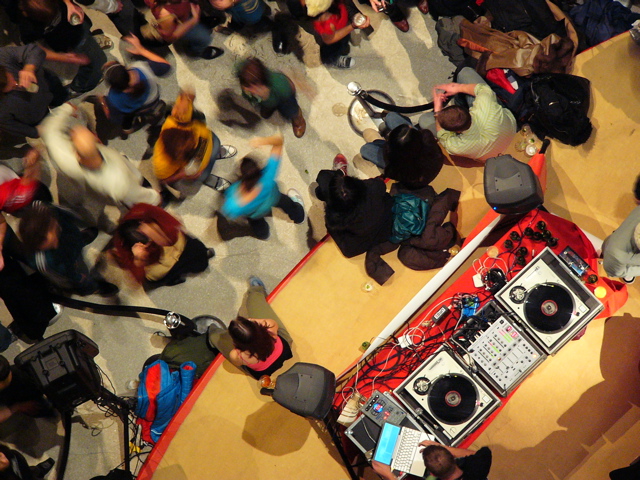 Little did I know that I was just in time for one of the more fun events I've ever attended in NYC: the First Fridays event celebrating the close of RUSSIA! with Diplo running DJ set until 1am. The line ran around the block even at 10pm, but membership has its privileges (totally kidding, folks, but this was my good luck for the evening having become a member for a totally unrelated reason...) Really neat seeing all of the art (amazing) with a huge crowd on the ground floor, and lots of others hanging over the walls of the ascending spiral. And the DJ set was excellent, especially seen from directly above (see the photos...)
Little did I know that I was just in time for one of the more fun events I've ever attended in NYC: the First Fridays event celebrating the close of RUSSIA! with Diplo running DJ set until 1am. The line ran around the block even at 10pm, but membership has its privileges (totally kidding, folks, but this was my good luck for the evening having become a member for a totally unrelated reason...) Really neat seeing all of the art (amazing) with a huge crowd on the ground floor, and lots of others hanging over the walls of the ascending spiral. And the DJ set was excellent, especially seen from directly above (see the photos...)
Naturally, I took a lot of photos. Have a look at my Flickr set!
 Little did I know that I was just in time for one of the more fun events I've ever attended in NYC: the First Fridays event celebrating the close of RUSSIA! with Diplo running DJ set until 1am. The line ran around the block even at 10pm, but membership has its privileges (totally kidding, folks, but this was my good luck for the evening having become a member for a totally unrelated reason...) Really neat seeing all of the art (amazing) with a huge crowd on the ground floor, and lots of others hanging over the walls of the ascending spiral. And the DJ set was excellent, especially seen from directly above (see the photos...)
Little did I know that I was just in time for one of the more fun events I've ever attended in NYC: the First Fridays event celebrating the close of RUSSIA! with Diplo running DJ set until 1am. The line ran around the block even at 10pm, but membership has its privileges (totally kidding, folks, but this was my good luck for the evening having become a member for a totally unrelated reason...) Really neat seeing all of the art (amazing) with a huge crowd on the ground floor, and lots of others hanging over the walls of the ascending spiral. And the DJ set was excellent, especially seen from directly above (see the photos...)Naturally, I took a lot of photos. Have a look at my Flickr set!
Friday, January 06, 2006
Lego(s) and the Scientific Outlook
 Fun season so far, but pretty busy overall. That said, an amusing issue popped up at lunch, yesterday. Chatting with a friend of mine, a plant biologist at BNL, we both realized that we both were Lego-obsessed kids. Then it turns out that he was part of a group of three friends growing up in England on the same street, who were all obsessed with those multicolored plastic blocks, and they all became scientists. Adding me to the sample, that's 4 for 4: anyone else out there?
Fun season so far, but pretty busy overall. That said, an amusing issue popped up at lunch, yesterday. Chatting with a friend of mine, a plant biologist at BNL, we both realized that we both were Lego-obsessed kids. Then it turns out that he was part of a group of three friends growing up in England on the same street, who were all obsessed with those multicolored plastic blocks, and they all became scientists. Adding me to the sample, that's 4 for 4: anyone else out there? 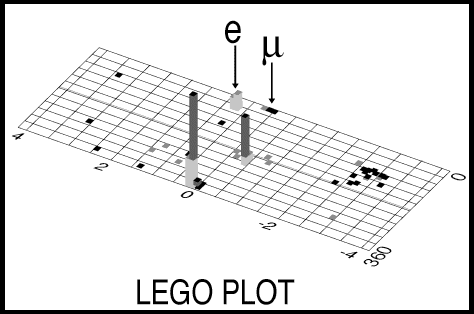 It's always amused me that high-energy physicist have been using "Lego plots" for years, but it never occurred to me that it could be part of a larger trend.
It's always amused me that high-energy physicist have been using "Lego plots" for years, but it never occurred to me that it could be part of a larger trend.I also learned that one doesn't play with "Legos" across the Atlantic. One plays "with Lego". Go figure.
Wednesday, January 04, 2006
artifact: relativator
 At last the loop is closed. It began as a mild-mannered post on Quantum Diaries last March, made a pit stop during a photo-shoot at BNL in late August, and has finally culminated in a bona-fide article in Symmetry Magazine (which I somehow didn't get in my mailbox!). Check out the PDF version with the full-page photo!
At last the loop is closed. It began as a mild-mannered post on Quantum Diaries last March, made a pit stop during a photo-shoot at BNL in late August, and has finally culminated in a bona-fide article in Symmetry Magazine (which I somehow didn't get in my mailbox!). Check out the PDF version with the full-page photo!
Monday, January 02, 2006
Preservation Hall Jazz Band
As the year ended, it was quite staggering to reflect on the insane menagerie of biblical-scale disasters which took place. It was thus quite moving to take in one of the performances by the Preservation Hall Jazz Band at the Jazz Standard in NYC. Amazing to consider that these guys have seen their home city (and homes, presumably) washed away but still maintain such a level of good humor, professionalism and sheer fun. We even got to see Allen Toussaint (a New Orleans legend, and a longtime fave of mine) amble out the door after the early show while we waited to descend down for the late one.
Sunday, January 01, 2006
Waiting For Einstein
 OK, this has made me mad. John Horgan, author of the much-debated (and unread-by-me) "The End of Science", has managed to secure himself the last page of this week's New York Times Book Review on which to tell us that "Einstein Has Left the Building."
OK, this has made me mad. John Horgan, author of the much-debated (and unread-by-me) "The End of Science", has managed to secure himself the last page of this week's New York Times Book Review on which to tell us that "Einstein Has Left the Building.""End of Science" was notorious when it came out in the mid-90's, since it claimed that most of the major discoveries had already been made (shades of the pre-Quantum era!) and that there was little left to do in fundamental physics but fill in a few details. The obvious point it seemed he missed was that science always looks this way, until it doesn't. In 1996 we had no accelerating universe, no WMAP, no RHIC (I must get my plugs in where I can!). In 2005 we simply know more than we did 10 years ago, but if science policy makers would have taken Horgan seriously (at least at the book-review level) we wouldn't have learned nearly as much, since they would have been under the impression there was nothing left to do.
The new article leaves a bad taste in my mouth as the World Year comes to a close. Horgan muses on how nothing important happened in 2005 despite all of the WYOP hype. Moreover, he seems to be implying that all of the attention paid to Einstein just makes us more cognizant of the possibility that there will never be another of his ilk. Rather than grapple with the big questions of the limits of time, space, and even technology, he argues that physics is far too involved with questions beyond the realm of testability, trotting out the usual complaints from him and others about the inaccessibility of string theory, extra dimensions, etc.
I have no interest in taking him on point-by-point, but I think he misses several obvious points. Firstly, even Einstein was "no Einstein" in 1905. The papers came out, and took years for the importance of all of them to be fully recognized by the scientific community. Thus, 2005 may well be a watershed year in science, but we just won't know that for at least a few years.
Of course, that comment could and does apply to any year. What really frustrates me is that he has missed the point of the world year of physics altogether. While the hype may have been over-the-top at times, it really revealed that people -- normal people, everywhere -- really like to hear about, and talk about, science. Moreover, while we may not get too many Einstein's, both in terms of depth and breadth of intellect, as well as moral commitment, we've at least reawakened a general sense that 1) science is important (take that, Dover), and 2) it's made by individuals (and not just institutions and governments, but that's another rant), and 3) no-one knows when a major discovery will happen. I can't imagine that the world experts in 1904 would have seen 1905 coming around the corner -- and I have trouble believing that science writers, or anyone, can predict the shape of the science to come. That said, nor should they preclude that science from happening by fomenting radical skepticism about the whole project.
OK, I'm not mad anymore. Back to work!
Subscribe to:
Posts (Atom)

